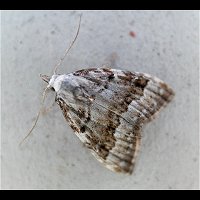Scarce Black Arches Nola aerugula
Scarce Black Arches is a small and unobtrusive moth. The basic colour is white. It is however covered in highly variable brownish or greyish bands and markings. The general shape of the animal however makes it rather umistakable. The only similar species is Least Black Arches, but usually that species flies earlier in the year. The protruding palps of the Black Arches may cause some confusing. Some might think they could be part of the big family of Snout Moths or Pyralids. The size plays a role in this confusion too, for Scarce Black Arches reaches a wingspan of some 15 to 20mm only.
The eggs are being laid in July and August. After hatching the young larvae do not become very active and remain small. As such they overwinter. After overwintering the larvae start feeding again to pupate in May in striking gondola-shaped cocoons. These are attached to the underside of a leaf, or in crevices of bark. The body of the caterpillar of Scarce Black Arches is greyish and so are the long hairs. A pinkish, orangelike yellow line runs on both sides of the back. Black markings are visible between the two lines. The head is dark brown. The first pair of legs is missing. The caterpillars reach a length of some 13 to 15mm.
Scarce Black Arches is on the wing from the end of June to the start of August in just one generation. Was a resident in Britain (Deal, Kent) up to 1898. Has been an immigrant since, seen on the coast of south and southeast England. The highest number recorded formally was eight in 1982. It strongly prefers sandy soils, making it a local species over much of Europe. Very common in the dunes of France, Belgium, Holland, Germany and Denmark, where most of the British immigrants probably originate.
Scarce Black Arches is a small and unobtrusive moth. The basic colour is white. It is however covered in highly variable brownish or greyish bands and markings. The general shape of the animal however makes it rather umistakable. The only similar species is Least Black Arches, but usually that species flies earlier in the year. The protruding palps of the Black Arches may cause some confusing. Some might think they could be part of the big family of Snout Moths or Pyralids. The size plays a role in this confusion too, for Scarce Black Arches reaches a wingspan of some 15 to 20mm only.
The eggs are being laid in July and August. After hatching the young larvae do not become very active and remain small. As such they overwinter. After overwintering the larvae start feeding again to pupate in May in striking gondola-shaped cocoons. These are attached to the underside of a leaf, or in crevices of bark. The body of the caterpillar of Scarce Black Arches is greyish and so are the long hairs. A pinkish, orangelike yellow line runs on both sides of the back. Black markings are visible between the two lines. The head is dark brown. The first pair of legs is missing. The caterpillars reach a length of some 13 to 15mm.
Scarce Black Arches is on the wing from the end of June to the start of August in just one generation. Was a resident in Britain (Deal, Kent) up to 1898. Has been an immigrant since, seen on the coast of south and southeast England. The highest number recorded formally was eight in 1982. It strongly prefers sandy soils, making it a local species over much of Europe. Very common in the dunes of France, Belgium, Holland, Germany and Denmark, where most of the British immigrants probably originate.




